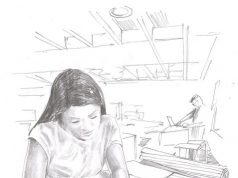Scientists at the University of Sussex have developed a piece of hardware to demonstrate how our brains function, as part of a growing range of equipment which uses DIY and 3-D printable models to open up access to science education.
Professor of Neuroscience, Tom Baden, has been working with colleagues to build Spikeling; a piece of electronic kit which behaves similarly to neurons in the brain.
Understanding how neurons encode and compute information is a central part of neuroscience but until now, opportunities for hands-on experience has been scarce.
But for just £25, Professor Baden may have found a way to make the process of learning neuroscience much more interactive.
Spikeling simulates how nerve cells in the brain compute information, with receptors that react to external stimuli like light.
Find your dream job in the space industry. Check our Space Job Board »
Students can then follow the activity of the brain cells and their underlying mechanisms live on a computer screen.
Multiple Spikelings can be linked together to form a network, showing how brain neurons interconnect; allowing scientists to demonstrate the behaviour behind every day actions like walking.
Professor Baden said: “Spikeling is a useful piece of kit for anyone teaching neuroscience because it allows us to demonstrate how neurons work in a more interactive way.”
Professor Baden and his team hope that Spikeling will become a useful teaching tool in neuroscience and the kit is already being put into practice, with the teaching of third year Neuroscience students at the University of Sussex, and at a summer school in Nigeria in 2017 where scientists were also taught how to build the hardware from scratch.
Spikeling is the latest in a line of equipment developed by Professor Baden, who also recently developed designs for a 3-D printable microscope called FlyPi, which can be set up with a basic unit for 100 Euros (compared to commercial microscopes costing thousands of dollars) and a pipette.
All have been made available openly with the design for Spikeling published on open access journal PLOS Biology.
Professor Baden explained: “With all parts being cheap, and design files being free and open, we hope that like any open Hardware design, Spikeling can be a starting point for others to change or extend it to their requirements, and reshare their improved design with the community.”
This is sharing of design files is a growing trend with hundreds of designs from the global community constantly collected on the PLOS Open Hardware toolkit, co-moderated by Professor Baden.
The overall aim for Baden’s lab, is to level the playing field in global science where equipment is otherwise expensive.
Andre Maia Chagas, a Research Technician in the lab, recently wrote an article advocating the need for open scientific hardware.
Also published in PLOS Biology, the article was a response to a piece by American neuroscientist Eve Marder which questioned whether researchers in less wealth institutions may be left behind as the equipment needed to perform scientific research becomes ever more expensive.
Professor Baden said: “By making access to scientific and teaching equipment free and open, researchers and educators can take the future into their own hands. In time, we hope that this type of work will contribute to level the playing field across the globe, such that ideas, not funding can be the primary driver for success and new insights”.
Provided by:
University of Sussex
More information:
Tom Baden et al. Spikeling: A low-cost hardware implementation of a spiking neuron for neuroscience teaching and outreach. PLOS Biology (2018). DOI: 10.1371/journal.pbio.2006760
Image:
An image of Spikeling, a £25 piece of electronic equipment developed at the University of Sussex to aid teaching about neurons in the brain
Credit: University of Sussex











